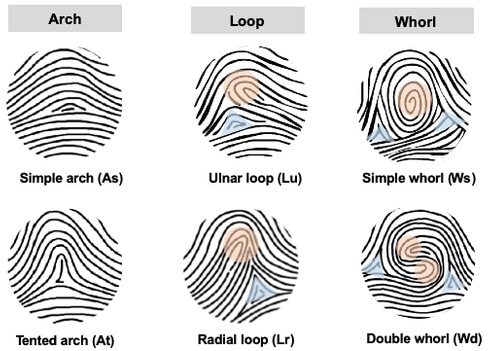Researchers found that the shape of fingerprints—whether they are circular, wavy, or wound—is determined by limb development genes instead of skin patterning genes, in the most thorough analysis to date. The observations help scientists better understand how genes influence phenotypic traits in humans. The study was published on January 6th, 2022, in the journal Cell.

This figure shows human fingerprint patterns are grouped into three types: arch, whorl and loop. Image Credit: Fudi Wang.
People may wonder why our team is working on fingerprints. We started the work purely out of curiosity. But later it turns out fingerprint pattern is associated with genes for limb growth, which are critical for fetal development. This provides another classic example of pleiotropy, when multiple phenotypes are interrelated to each other and are affected by the same genes.”
Sijia Wang, Study Co-Senior Author and Geneticist, Shanghai Institute of Nutrition and Health, Chinese Academy of Sciences
Although fingerprints are unique to each individual, they can generally be divided into three types: arch, loop, and whorl. In the third month of pregnancy, a fetus’ fingers and toes begin to form furrows and ridges. Fingerprints may have evolved to make it easier to grasp objects and sense their textures, but scientists do not know exactly how these patterns develop.
In a study involving DNA from over 23,000 people of various ethnicities, Wang and colleagues found that at least 43 regions on the genome are associated with fingerprint patterns. A gene called EVI1 appears to be highly influential in regulating the expression of one of the most important regions in the development of embryonic limbs.
The team modified mice’s DNA to reduce their expression of EVI1. As compared with wild-type mice, mice with down-regulated EVI1 had abnormal skin patterns on their digits.
The fingerprint patterns of humans are genetically associated with finger length, according to the study. For instance, people with whorl-shaped fingerprints on both of their little fingers are more likely to have longer little fingers than others, because genes involved in limb development are strongly correlated with this trait.
We don’t know exactly how the genes shape fingerprint patterns, but it could be determined by the amount of strength from growth that’s put on an embryonic tissue called volar pads that plays an important role in the formation of different patterns of fingerprint.”
Jinxi Li, Study Co-First Author and Geneticist, Human Phenome Institute, Fudan University, Shanghai
She explains that as a fetus grows, its fingers and palms extend and stretch. In such an instance, these forces may cause a whorl to become a loop.
“Notably, previous research has suggested that EVI1 is linked to risk of leukemia, and some studies have observed that people with more whorl patterns are more susceptible to the disease,” adds Wang. Sometimes, children with Down’s syndrome tend to have a single crease on their palms.
Many congenital genetic disorders are related to different dermatoglyphic patterns, such as fingerprints. Our study suggests that dermatoglyphic patterns are affected by crucial development genes, which provides a strong theoretical basis for this kind of pleiotropy.”
Sijia Wang, Study Co-Senior Author and Geneticist, Shanghai Institute of Nutrition and Health, Chinese Academy of Sciences
Source:
Journal reference:
Li, J., et al. (2022) Limb development genes underlie variation in human fingerprint patterns. Cell Press. doi.org/10.1016/j.cell.2021.12.008.